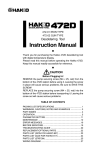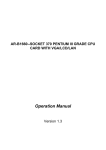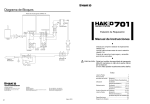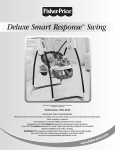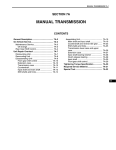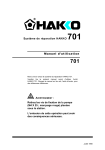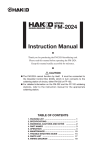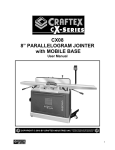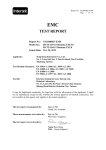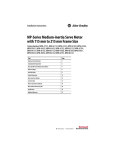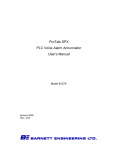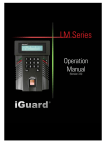Download specs & user`s manual
Transcript
® Desoldering Tool Instruction Manual ● Thank you for purchasing the Hakko 472D desoldering tool with digital temperature display. Please read this manual before operating the Hakko 472D. Keep this manual readily accessible for reference. ● CAUTION Before Plugging In! REMOVE the pump securing screw (M4 × 25, red) from the bottom of the 472D station before using it. Leaving the screw in place will cause serious problems. Be sure to SAVE THIS SCREW! REPLACE the pump securing screw (M4 × 25, red) into the bottom of the 472D station before transporting it. Leaving the screw out will cause serious problems. TABLE OF CONTENTS PACKING LIST / SPECIFICATIONS .............................................. 1 WARNINGS, CAUTIONS, NOTES AND EXAMPLES ................... 2 PART NAMES ............................................................................... 3 OPERATION .................................................................................. 4 PARAMETER SETTING ................................................................ 8 MAINTENANCE ............................................................................ 9 REPLACEMENT PARTS ............................................................. 12 ERROR MESSAGES ................................................................... 14 BEFORE SERVICING ...... .......................................................... 14 REPLACEMENT/OPTIONAL PARTS .......................................... 15 PARTS LIST (IRON) .................................................................... 16 PARTS LIST (STATION) .............................................................. 17 WIRING DIAGRAM ...................................................................... 19 Please check to make sure that all the items listed below are included in the Hakko 472D package. PACKING LIST Station ............................................................. 1 Desoldering iron (Hakko 807) ......................... 1 Filter pipe [w/filter holder, spring filter & ceramic paper filter (L)] ................ 1 Spring filter ...................................................... 3 Ceramic paper filter (S) ................................... 2 Ceramic paper filter (L) ................................... 4 Cleaning pin for ø1.0 mm (0.04 in.) nozzle ..... 1 Cleaning pin for heating element .................... 1 Iron holder ....................................................... 1 Instruction manual .......................................... 1 Control card .................................................... 1 Card chain ....................................................... 1 Iron holder Desoldering iron (Hakko 807) Station Filter pipe Control card/Card chain Spring filter Ceramic paper filter (S) Cleaning pin for heating element Cleaning pin for ø1.0 mm (0.04 in.) nozzle Ceramic paper filter (L) SPECIFICATIONS Station Hakko 472D Desoldering iron Hakko 807 Power consumption 120V AC, 110W Power consumption 24V AC, 60W Vacuum pressure 80 KPa (600 mmHg)(24 in.Hg) Temperature range 350-450°C (662-842°F) Suction flow 15 liters/min Total length (w/o cord) 205 mm (8.07 in.) Nozzle to ground potential Under 2 m V Weight (w/o cord) Nozzle to ground resistance Under 2 Ω Outer dimensions (l × w × h) 263 × 160 × 148 mm (10.4 × 6.3 × 5.8 in.) Weight (w/o cord) 1 4.6 kg (10.14 lb.) Aprox.160 g (0.35 lb.) WARNINGS, CAUTIONS, NOTES AND EXAMPLES Warnings, cautions and notes are placed at critical points in this manual to direct the operator’s attention to significant items. They are defined as follows: WARNING: Misuse may potentially cause death of, or serious injury to the user. CAUTION: Misuse may potentially cause injury to the user or physical damage to the objects involved. For your own safety, be sure to comply with these precautions. NOTE: A NOTE indicates a procedure or point that is important to the process being described. EXAMPLE: An EXAMPLE is give to demonstrate a particular procedure, point or process. CAUTION Remove the pump securing screws (M4×25 marked red) from the bottom of the station. Failure to do so may result in serious problems. Be sure to save this screw. When the power is on, the nozzle temperature will be between 350°C/662°F and 450°C/ 842°F. Since mishandling may lead to burns or fire, be sure to comply with the following precautions. ● Do not touch the metallic parts near the nozzle, nearby plastic parts and the iron holder . ● Do not use the product near flammable items. ● Advise other people in the work area that the unit can reach a very high temperature and should be considered potentially dangerous. ● Turn the power off when no longer using the Hakko 472D or leaving it unattended. ● Before replacing parts or storing the unit, turn the power off and allow the unit to cool to room temperature. To prevent accidents and failures, be sure to take the following precautions: ● Do not use the unit for applications other than desoldering. ● Do not rap the desoldering iron against the work bench to shake off residual solder, or otherwise subject the iron to severe shocks. ● Do not modify the unit. ● Use only genuine Hakko replacement parts. ● Do not wet the unit or use the unit with wet hands. ● Set the ceramic paper filter (S) for the filter retainer (station), and the ceramic paper filter (L) for the filter pipe (Iron). ● Maintain the desoldering gun and the station. ● While using the unit, don’t do anything which may cause bodily harm or physical damage. 2 PART NAMES ● Station Temperature display Heater lamp Control card slot CAL POT Membrane sheet UP Iron holder CAL DOWN VACUUM IRON POWER Power switch Vacuum outlet cap Receptacle Fuse holder Control card Power cord ● Desoldering iron Cord assembly Nozzle Button Filter pipe (Inside housing) Heating element (Inside pipe) 3 Hose Back holder OPERATION ● Attach the iron holder. Remove the iron holder mounting screws from the side of the station. Attach the iron holder to the station. (Figure 1) (The iron holder can be installed on the either the left or right side.) (Figure 1) ● Attach the desoldering iron. 1. Insert the filter pipe (with a filter holder, spring filter and ceramic paper filter (L)) into the housing. Push and turn the back holder clockwise. (Figure 2) 2. Connect the cord assembly of the Hakko 807 to the receptacle. (Figure 3) (Figure 2 ) 3. Connect the hose to the vacuum outlet cap. (Figure 4) 4. Set the iron in the iron holder. (Figure 5) Insert the cord assembly by keying the plug to the key on the receptacle. VACUUM 5. Plug the power cord into the power supply and turn the power switch to ON ( ). CAUTION: Be sure the power switch is OFF ( ) before connecting the desoldering iron cord. Failure to do so may result in damage to circuit board. Attach the hose securely over the vacuum outlet cap. (Figure 4) Secure the plug by turning it clockwise. ● Desoldering (Figure 3) 1. Set the temperature. (Refer to P.6) NOTE: Always set the temperature as low as possible for the work being done. The temperature can be adjusted between 350 – 450°C (662 – 842°F). CAUTION When not in use, place the iron on the iron holder. (Figure 5 ) Top view 4 OPERATION 2. Clean the tip of the nozzle. Keep the tinned section of the nozzle clean and shiny by coating it with a small amount of solder. If the tip of the nozzle is coated with oxide, the nozzle’s heat conductivity will be lowered. Coating the tip with a small amount of fresh solder ensures maximum heat conductivity. Nozzle cleaner (Optional parts) Wipe away any oxide or old solder from the nozzle using the hole in the center of the sponge. NOTE: The cleaner is not included. 3. Melt the solder. • Apply the nozzle to the soldered part and melt the solder. NOTE: Never allow the nozzle to touch the board itself. Nozzle P.W.B. Solder Lead • Confirm that the solder is melted. NOTE: • To confirm that all the solder is melted, observe the inside of the hole and the backside of the P.W.B. If this is difficult to do, try slowly moving the lead with the nozzle if the lead moves, the solder is melted. • Never move the lead by force. If it doesn’t move easily, the solder is not yet fully melted. 4. Extract the solder. After confirming that the solder is completely melted, extract the solder by pushing the button on the iron. NOTE: Never leave any solder remaining inside the hole in the P.W.B. 5. Problems during desoldering. If solder remains, resolder the component and repeat the desoldering process. 5 Slowly move the lead with the nozzle. Extract the solder by slowly moving the lead back and forth with the tip of the nozzle. ● Factory setting The Hakko 472D comes from the factory with the following values preset: Temperature scale °F Low temperature alarm setting 120 Set temperature 750 ● Control card Each Hakko 472D comes with a small card, which inserts in the control slot in the front of the unit. This card is used when entering data for the process control functions. Any Hakko 472D card can be used with any Hakko 472D soldering station. Using the control card The control card is used when a value is to be changed or data are to be entered. The Hakko 472D will operate normally with the card inserted. Remove the control card to lock the data. ● Setting/Changing the temperature 1. Insert the card into the card slot in the front panel of the station. • The HUNDREDS digit in the display begins to flash, indicating that the station is in the temperature setting mode and data can be entered. 2. Enter the HUNDREDS digit • Use the or button to select the desired value for the HUNDREDS digit. For setting in degrees Celsius, either 3 or 4 can be selected. For settings in degrees Fahrenheit, values between 6 and 8 can be selected. When the desired value is displayed, press the button. Example : Change the temperature from 700°F to 840°F Insert the card. Press the UP or DOWN button. Press the button once. 6 OPERATION 3. Enter the TENS digit or button to select the • Press the desired value for the TENS digit. Any value from 0 to 9 can be selected. When the desired value is displayed, press the button. The UNITS digit begins to flash. 4. Enter the UNITS digit • Use the or button to select the desired value for the UNITS digit. Any value from 0 to 9 can be selected. When the desired value is displayed, press the button. This will store the temperature setting in memory and display the temperature setting. Heater control begins. Remove the card to lock the data. Press the UP or DOWN button. Press the button once. Press the button once. NOTE: If the power switch is turned off, or power is lost during the execution of this procedure, no data will be entered. The entire procedure must be repeated from step 1. When the station is ON ( ) and the card is in the station, the data entry procedure follows: 1. Hold the second. button down for at least one 2. The current temperature setting will be displayed, then the HUNDREDS digit will begin to flash. This indicates that the station has entered the temperature setting mode. 3. Continue with the procedure of 2-4 above. 7 PARAMETER SETTING The HAKKO 472D has the following parameters. Parameter settings can be adjusted. 1. °C or °F temperature display selection. 2. Low temperature tolerance. 3. Display of room temperature compensation value (test mode) Once parameter input mode has been entered, set the parameters in the order shown below. After all the parameters have been set, normal operation will be resumed. 1. °C (Celsius) or °F (Fahrenheit) Temperature Display 1. Turn off the power switch. 2. Insert the control card into the slot in the station. 3. Press and hold the and buttons simultaneously, then turn on the power switch. 4. Continue holding down the and buttons until the display shows °C (for Celsius) or °F (for Fahrenheit). 5. When the display shows °C or °F, the station is in parameter input mode. 6. Pressing the or button will cause °C or °F to be displayed alternately. button to select the scale. The low temperature 7. Press the tolerance may now be entered. 2. Low temperature tolerance (Flashing of the temperature display) When the station enters the Low temperature tolerance setting mode, the HUNDREDS digit will begin flashing. Enter and store the value in the same manner as described in ‘Changing the temperature setting’. Range of allowable heater error temperatures For °C: 30 – 150°C For °F: 60 – 300°F If a temperature value outside this range is selected, the display will again flash the HUNDREDS digit. If this happens, reenter a correct temperature value. After setting the low temperature tolerance value, the display will show the room temperature compensation value (test mode). 3. Room Temperature Compensation Value. (Test Mode) The display will not blink and the heater will not receive power. The room temperature compensation value is the measured temperature of the nozzle. This function will be used later to calibrate the nozzle temperature. (See “Recalibrate the Temperature” on P.13) No inputs are made here. Press to complete parameter input. The nozzle temperature setting will be displayed for 2 seconds, after which power will be supplied to the heater and normal temperature control will begin. 8 MAINTENANCE Efficient desoldering depends upon the temperature, the quality and quantity of the solder and flux. Perform the following service procedures as dictated by the conditions of the iron usage. During maintenance, please wear gloves and work carefully. WARNING: Since the desoldering iron can reach a very high temperature, please work carefully. Except when cleaning the nozzle and heating element, always turn the power switch off and disconnect the power plug before performing any maintenance procedure. Servicing the Desoldering Iron Cleaning with the nozzle cleaning pin. 1. Inspect and clean the nozzle. • Plug in the power cord, turn the power switch “ON” and let the nozzle heat up. • Clean out the hole of the nozzle with the nozzle cleaning pin. If the nozzle cleaning pin does not pass through the nozzle, use the cleaning drill (option). NOTE: • The cleaning drill is not included. • The cleaning pin will not pass through the nozzle until the solder inside the nozzle is completely melted. • Check the condition of the solder plating, surface and inside hole of the nozzle. If it is slightly worn, recoat the tip with fresh solder. • If it is worn or eroded, or the inside diameter seems unusually wide, replace the nozzle. The cleaning pin passes completely through the hole. Cleaning with the cleaning drill (option). • Before cleaning Insert the bit while turning it clockwise. • After cleaning Pull the drill bit out straight without turning it. solder plating CAUTION Please use the proper sized cleaning pin or cleaning drill for the nozzle diameter. NOTE: The inside hole and the surface of the nozzle is plated with a special alloy. Should this alloy become eroded by high temperature solder, the nozzle will not be able to maintain the proper temperature. • If the cleaning pin and cleaning drill do not pass through the hole in the nozzle, replace the nozzle. 9 CAUTION If the cleaning drill is forced into the nozzle, the drill bit could break or be damaged. Diameter of hole is widened through erosion. NOTE: Unfortunately, it is often difficult to observe this condition, therefore, if desoldering efficiency goes down and all other parts appear to be OK, the nozzle is probably eroded and should be replaced. 2. Disassemble the heating element part. Element cover Heating element Nozzle CAUTION: The heating element is very hot during operation. 3. Clean out the hole in the heating element. Be sure the solder in the hole in the heating element is completely melted, then clean the hole with the cleaning pin provided. If the cleaning pin cannot pass through the hole, replace the heating element. Cleaning the inside of the filter case Nut Remove the nut with the spanner. Scrape away all oxidation from the hole in the heating element until the cleaning pin passes cleanly through the hole. The cleaning pin passes cleanly through the hole. VACUUM 1. Replace the ceramic paper filter (S). Remove the ceramic paper filter (S) and inspect it. If it is stiff with flux, replace it. Filter retainer Remove the filter retainer and push out the ceramic paper filter. Ceramic paper filter (S) 2. Reassemble the filter case. Ceramic paper filter (S) Secure the vacuum outlet cap. CAUTION: Insert the small ceramic paper filter into the filter retainer at the station. Using the large ceramic paper filter may damage the unit, or reduce the effectiveness of the unit. Apply silicone grease to the O-ring (S-20) and securely tighten the vacuum outlet cap to prevent air leakage. 10 MAINTENANCE Cleaning the pump 1. Disassemble the pump heads. • Unplug the power cord. • Remove the cover screws. (right/left) • Remove the cover. • Remove the pump head from each side of the pump. 2. Clean the pump head. • Remove the valve plate and fixing plate. • Remove any flux adhering to the plates. • If the valve plate is bent or stiff, replace it. • If the exhaust filter is dirty, replace it. CAUTION: • If the fixing plate is difficult to remove, apply hot air to it to warm it up. • Never use excessive force to remove the plate as it is easy to bend, and a bent plate will allow a leak, which reduces the efficiency of solder extraction. • Clean the plates only with alcohol or thinner. 3. Assemble the pump heads. Clean the pump head and fixing plate. Fixing plate Valve plate Pump head Exhaust filter Pump head Reassemble the valve plate and fixing plate. CAUTION: When assembling the pump, be sure to check for air leaks. Valve plate Fixing plate Be sure the parts are aligned correctly. 11 REPLACEMENT PARTS ● Replacing the filters. Ceramic paper filter(L) 1. Turn the back holder knob counterclockwise and pull out the filter pipe. 2. If there is solder in two-thirds of the spring filter, replace the filter. 3. If the ceramic paper filter is stiff with flux and solder, replace the filter. 4. Insert the spring filter into the filter pipe. 5. Insert the ceramic paper filter and put the back holder into the filter pipe. 6. Insert the filter pipe into the main body and secure it by turning the back holder knob clockwise. Spring Ffilter Filter holder Filter pipe Back holder Front holder Filter holder Spring filter CAUTION Securely insert the spring filter to the end of the filter holder. ● Replacing the heating element Check the resistance value The resistance values of a working heating element are 9.2Ω between pins 1 and 3 (heating element), 54Ω between pins 2 and 4 (sensor) at 73°F (23°C) If the measured values are outside this range, replace the heating element. (No. A1174 24V-60W heating element for Hakko 807) Pins 1 4 3 2 Nut Fig. 1 Nozzle Element cover Replacing the heating element 1. Unplug the cord. 2. Remove the nut, element cover, and nozzle. 3. Turn the back holder knob counterclockwise and pull out the filter pipe. 4. Remove the housing fastener. 5. Remove the screws securing the housing 9 and the screws 3 4 securing the flange to the housing. 6. Remove the front holder. 7. Remove the screw 5 6 7 securing the heating element to the flange, and the screw 1 2 . Fig. 2 24V 60W Fastener Fig. 3 Back holder knob 9 Front holder 9 5 3 1 7 6 2 24V 60W 4 Fig. 4 12 REPLACEMENT PARTS 8. Desolder the heating element leads (marked H) and sensor leads (marked S). 9. Remove the old heating element and replace it with a new one. 10. Bend the lead wire as shown in Fig. 6, and pass two red leads and two white leads through the holes as shown in Fig. 7. Secure a heating element to the flange with the screws 5 6 7 . 11. Install the front holder. 12. Resolder the heating element leads (red wires/H) sensor leads (white wires/S). 13. Reassemble the unit. S S H H Fig. 5 Wires Fig. 6 CAUTION Be careful not to twist and pull the lead wire when installing the heating element. Pass the leads through the holes as shown. Flange Two red leads Two white leads Fig. 7 NOTE: Be sure the insulation on the leads touches the board. Do not leave any bare wire exposed. ● Recalibrate the temperature (a) Set the desire temperature. (b) Adjust the temperature calibration pot (CAL) until the nozzle temperature (measured with a tip thermometer) is correct. 13 ERROR MESSAGES Various error messages will be displayed when there is a problem with the Hakko 472D unit. If the following message is displayed, refer to “Trouble Shooting Guide”. System Error After the power has been turned on, the system checks the memory and the programs. If an abnormality is found, will be displayed, and all operations will be completely stopped. Sensor Error If there is a possibility of a failure in the sensor or will be anywhere in the sensor circuit, displayed and power to the desoldering iron will be cut off. The sensor error also occurs if the cord assembly is not properly connected. Low temperature tolerance If power is present at the desoldering iron and the nozzle temperature goes below the heater error temperature tolerance setting, the temperature display will flash. This indicates the possibility of a heater malfunction. (Flashing of the temperature display) EXAMPLE: Assume the temperature setting is 400°C (750°F) and the low temperature tolerance is 50°C (100°F). If, even though the heater is receiving power, the temperature of the desoldering iron goes below 350°C (650°F) the display will begin to flash indicating a possible heater malfunction. EXAMPLE: 400°C – 50°C = 350°C (750°F – 100°F = 650°F) → The display will begin to flash. NOTE: If the temperature begins to rise again, the display will stop flashing – even if the displayed temperature is below 350°C (650°F). BEFORE SERVICING ...... WARNING: • Disconnect the power plug before servicing. Failure to do so may result in electric shock. • If the power cord is damaged, it must be replaced by the manufacturer, its authorised service agent, or a similarly qualified technician to avoid hazard. 14 REPLACEMENT/OPTIONAL PARTS • Nozzle Part No. A1002 A1003 A1004 A1005 A1006 A1007 Part name/Description Nozzle S ø0.8 mm (0.03 in.) / Small Nozzle S ø1.0 mm (0.04 in.) / Small Nozzle ø0.8 mm (0.03 in.) Nozzle ø1.0 mm (0.04 in.) Nozzle ø1.3 mm (0.05 in.) Nozzle ø1.6 mm (0.06 in.) øB øA Replacement and optional parts for Hakko 807 øA 0.6 mm (0.023 in.) 0.8 mm (0.03 in.) 1.0 mm (0.04 in.) 1.0 mm (0.04 in.) 1.3 mm (0.05 in.) øB 1.5 mm (0.059 in.) 1.8 mm (0.07 in.) 2.0 mm (0.08 in.) 1.4 mm (0.055 in.) 2.1 mm (0.083 in.) øA 0.8 mm (0.03 in.) 1.0 mm (0.04 in.) 1.3 mm (0.05 in.) 1.6 mm (0.06 in.) 2.3 mm (0.09 in.) øB 2.3 mm (0.09 in.) 2.5 mm (0.1 in.) 3.0 mm (0.12 in.) 3.0 mm (0.12 in.) 3.8 mm (0.15 in.) øB øA Part No. A1487 A1002 A1003 A1393 A1395 Part No. A1004 A1005 A1006 A1007 A1396 øB øA 11 mm (0.43 in.) Part No. øA øB A1394 1.0 mm (0.04 in.) 2.1 mm (0.083 in.) • Cleaning Pin/Drill Part No. B1215 B1086 B1087 B1088 B1089 B1302 B1303 B1304 B1305 Spanner, cleaning brush, silicone grease, iron holder 15 Part No. B2100 B1670 A1028 C1316 Part name/Description Cleaning pin for heating element Cleaning pin for ø0.8 mm (0.03 in.) nozzle Cleaning pin for ø1.0 mm (0.04 in.) nozzle Cleaning pin for ø1.3 mm (0.05 in.) nozzle Cleaning pin for ø1.6 mm (0.06 in.) nozzle Cleaning drill for ø0.8 mm (0.03 in.) nozzle Cleaning drill for ø1.0 mm (0.04 in.) nozzle Cleaning drill for ø1.3 mm (0.05 in.) nozzle Cleaning drill for ø1.6 mm (0.06 in.) nozzle Part name/Description Spanner (for desoldering iron) Cleaning brush Silicone grease Iron holder for Hakko 807 PARTS LIST (Iron) NOTE: Spare or repair parts do not include mounting screws, if they are not listed on the description. Screws must be ordered separately. 12 16 15 17 13 11 19 8 9 10 Pan head screw M2.6 × 7 (1) Sus 7 14 Pan head screw M2.6 × 7 (7) Sus 18 5 6 3 1 2 4 Item No. 1 2 3 4 5 6 7 8 9 10 11 12 13 14 15 16 17 18 19 Part No. B1653 A1174 B1015 B1654 A1304 A1030 B1655 B1656 B1916 A1033 B1657 B1917 B1659 B1023 B1024 B1660 B1915 B2517 Part Name Description Nozzle See P.15 Element cover Heating element 24V-60W Nut Flange Front holder Spring filter Set of 10 Button Board With switch Filter pipe Ceramic paper filter (L) Set of 10 Cord assembly Back holder assembly Housing With a screw & fastener Hose Cord holder Set of 4 Housing fastener Filter holder Filter pipe asse’y With filter holder & filters 16 PARTS LIST (Station) NOTE: Spare or repair parts do not include mounting screws, if they are not listed on the description. Screws must be ordered separately . Pan head screw with washer M4 × 30 Pan head screw with washer M4 × 8 (4) Truss screw Ni M4 × 5 (8) External tooth lock washer Nominal size 4 16 17 Pan head screw with washer M3 × 6 (8) Spacer Nominal size 4 × 25 Pan head screw with washer M4 × 6 Truss screw M4 × 5 (4) External tooth lock washer Nominal size 4 21 18 ● 472D Station Item No. 1 2 3 4 5 6 7 8 9 10 11 12 13 14 15 16 17 18 19 20 21 22 23 24 25 26 27 28 29 30 31 32 33 34 35 36 17 Part No. Part Name B1029 A1009 B1063 B1034 B1031 B1064 B1662 B1084 B1204 B2724 B2314 B2726 B2727 B2047 B2388 B2444 B2728 B1041 B1275 B2068 Vacuum outlet cap Ceramic paper filter (S) Filter retainer O-ring Vacuum outlet retainer Filter case joint Receptacle Power switch Rubber foot Chassis Hose assembly P.W.B. for display P.W.B. for heat control Membrane sheet Control card Pump assembly Transformer Fuse holder Fuse Power cord, 3 core & American plug Cover Iron holder Balance weight Crank Damper Ring for bearing Crank shaft Pump flame Motor Diagram Diagram setting plate Fixing plate Valve plate Pump head Exhaust filter Filter retaining pin B2725 B2729 B1053 B1312 B2506 B1057 B2060 B2059 B2058 A1013 B2085 B1056 A1014 B1050 B1059 B1313 13 12 Pan head screw with washer M4 × 6 19 22 Description Set of 10 Pan head screw with washer M3 × 6 External tooth lock washer Nominal size 4 23 24 S-20 With O-ring & screws Pan head screw with washer M3 × 6 (4) 25 With rubber foot 20 27 26 11 28 250V-2A (U) Pan head screw with washer M4 × 12 (8) 32 With screw 35 36 10 8 30 31 33 Set of 2 29 Flat head screw M4 × 12 (2) 34 7 Flat head screw M4 × 8 (4) Spring washer Nominal size 4 (4) Hexagon nut M4 (4) 14 9 6 Pan head screw M4 × 25 2 5 4 15 3 1 Set of 2, with screws Set of 2 With screws Set of 2 18 WIRING DIAGRAM Motor Switch 2 2 1 1 1 5 Iron 2 P.W.B. for control CN2 1 3 4 3 CN1 CN3 Power cord 1 4 1 3 CN2 1 CN1 4 Fuse holder P.W.B. for display Transfomer HEAD OFFICE 4-5, SHIOKUSA 2-CHOME, NANIWA-KU, OSAKA, 556-0024 JAPAN TEL:+81-6-6561-3225 FAX:+81-6-6561-8466 http://www.hakko.com/ AMERICAN HAKKO PRODUCTS, INC. 28920 N. AVENUE WILLIAMS VALENCIA CA 91355, U.S.A. TEL: (661) 294-0090 FAX: (661) 294-0096 Toll Free (800)88-HAKKO www.hakkousa.com 4 2 5 5 6 19 Nov. 2001 MA01080JU011107



















